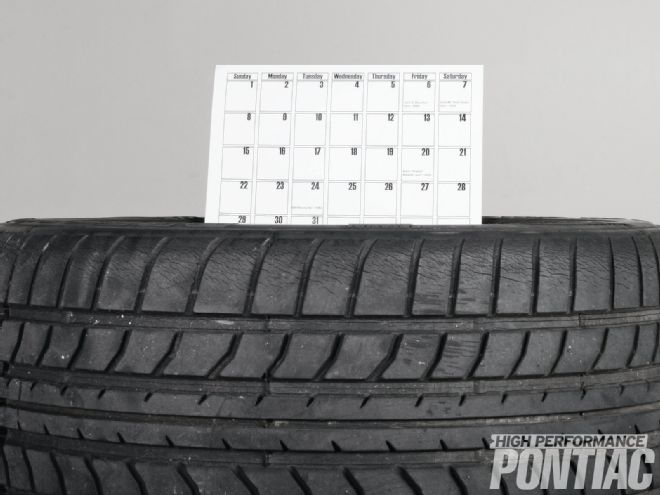
For many Pontiac hobbyists, original-equipment tires are a sign of heritage and honor. They signify a car’s low-miles, pampered life, and the preservation of brand history. That’s why, although uncommon, it’s not impossible to find survivors from the ’60s and ’70s still wearing their decades-old rubber and a plethora of late-model Pontiacs—from ’09 back to the late-’80s—still rolling on original tread.
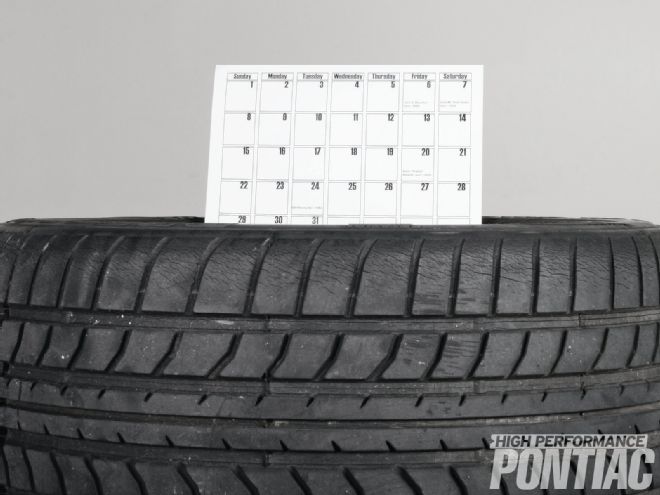
Many consumers have heard of the Tire Industry Association’s minimum tread-depth rule, which states you should replace your tires when they reach no less than 2⁄32-inch of tread depth, and most follow it simply as a matter of safety. Like seatbelt laws, however, 44 states have passed minimum tread-depth legislation with warnings or tickets for those who break these mandates.
What about your tires’ age and how it effects their retirement? Is it safe to keep tires in service—OE and aftermarket-replacement alike—if they are 10, 20, or 30 years old, regardless of whether they retain more than the minimum-recommended tread? According to one industry expert, the answer is no.
“Due to the wide range of usage and environmental conditions that a tire can experience, it’s impossible to predict the age at which a tire should be removed from service,” says Doug Girvin, director of product marketing, Passenger Car and Light Truck Tires, for Michelin North America, the parent company of BFGoodrich. “Therefore, we recommend that tires be inspected annually after five years of service by a trained tire specialist to assess whether they should remain in service. Most tires will be replaced before 10 years, but all tires should be replaced after 10 years regardless of their condition.”
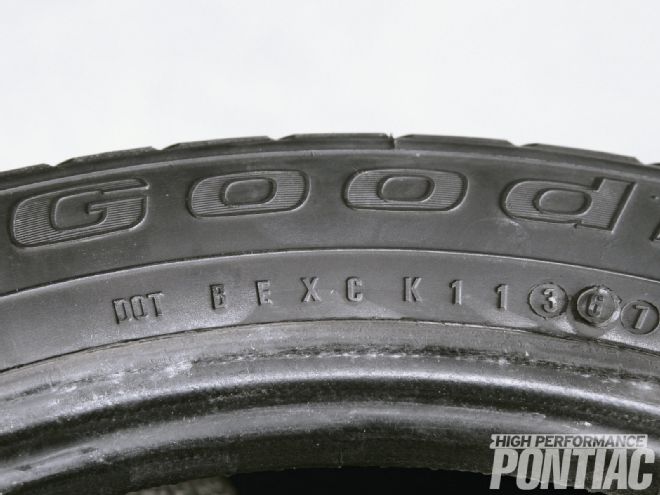 The manufacturer date code on our tires reads “367.” Prior to 2000, the first two digits specify the week of the year and the last digit is the year of the decade. (In 2000, the U.S. Department of Transportation mandated a four-digit date code: two digits for the week followed by two digits for the year.) That means these high-performance BFGs were produced the 36th week of 1997, putting them close to 14 years old.
The manufacturer date code on our tires reads “367.” Prior to 2000, the first two digits specify the week of the year and the last digit is the year of the decade. (In 2000, the U.S. Department of Transportation mandated a four-digit date code: two digits for the week followed by two digits for the year.) That means these high-performance BFGs were produced the 36th week of 1997, putting them close to 14 years old.
Are tires on collector cars or show cruisers exempt from the rule?
“No,” Girvin says. “They should be inspected just like tires on any other vehicle and removed after 10 years of service. Tires continue to age even on vehicles that are driven infrequently.”
So how much do tires age from their manufacture date to their 10th birthday and beyond, prompting BFGoodrich, Michelin, and other tire manufacturers to adopt the 10-year rule? To answer that question, High Performance Pontiac enlisted the services of Autoway Chevrolet in Clearwater, Florida, where Assistant Service Manager Chris Sullo had one of the GM Master Techs dismount the BFGoodrich Comp T/A 275/40ZR17s that came as extra-cost original equipment on our ’98 Mecham Trans Am. We then sent the foursome to Michelin North America and asked its team of engineers to examine and evaluate them for age-related wear. Company experts used a five-step tire-inspection method, which you can ask a tire-shop tire specialist to follow for the tires on your Pontiac.
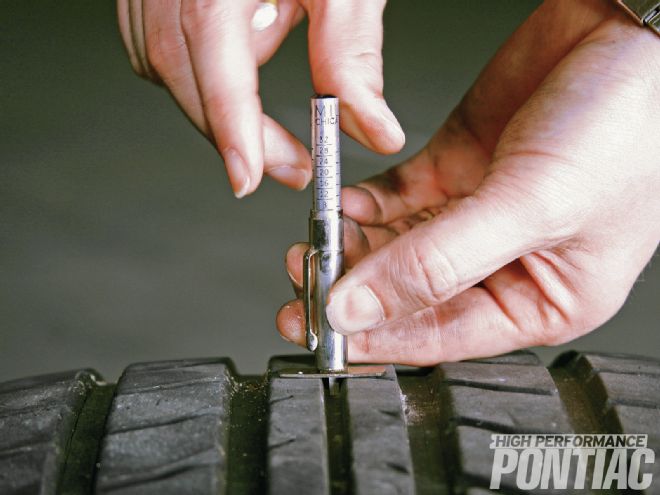 Chris measured the tires’ tread depths and discovered they had ample rubber-depth remaining (7⁄32-inch on both front tires and 5⁄32-inch on both back tires), thanks to the Bird’s documented 19,000-mile conservative driving history.
Chris measured the tires’ tread depths and discovered they had ample rubber-depth remaining (7⁄32-inch on both front tires and 5⁄32-inch on both back tires), thanks to the Bird’s documented 19,000-mile conservative driving history.
The twist here is that these tires are not worn out from a tread-depth perspective, so they can instill confidence in the owner that they are roadworthy and safe. But deep tread doesn’t mean there isn’t any age-related deterioration, hence the evaluation at Michelin.
Check out the photos and captions to see how we prepared the tires for testing, what Michelin’s engineers found, and their final recommendation, which we asked them to base solely upon their inspection and not upon the actual age of the tires.
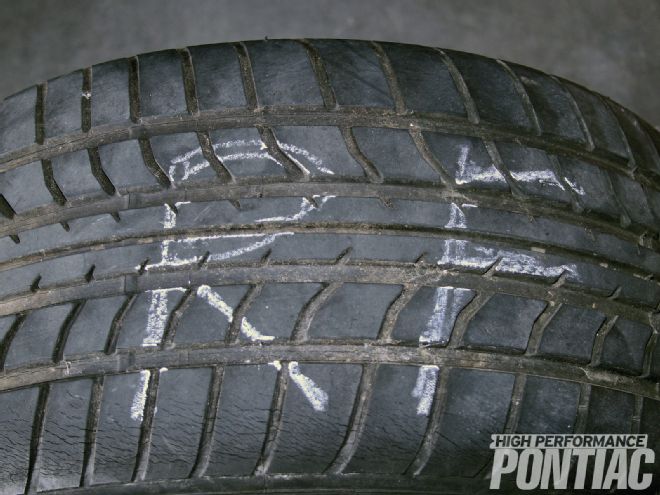 He then marked the tires’ orientation on the T/A.
He then marked the tires’ orientation on the T/A.
Final Evaluation
Though our tires passed three out of five of the Michelin’s recommended tire-retirement evaluation steps, they were not so lucky on Steps Three and Four, in which the engineers evaluated the tread and sidewall surfaces.
“These tires have significant ozone cracking beyond cosmetic cracking on the tread surface and shoulder zone, along with some minor cracking on the sidewall,” Girvin concluded. “There’s no other visible sign of aging damage on their exterior and interior, and they all have even tread wear with no signs of irregular wear. Even if the subject tires were less than five years old, we would recommend removing them from service solely based on the depth of cracking on the longitudinal tread grooves.”
Conclusion
There’s solid reasoning behind the 10-year rule for tire replacement—almost all tires, regardless of manufacturer, will fail one or more of Michelin’s recommended tire-retirement evaluation steps sometime between 5 and 10 years old.
“The biggest concern with tire aging is the integrity of the tire, as well as potential failure. The reason we’ve pointed out the signs of potential integrity issues is to make sure that everyone has a safe and enjoyable ride.” Girvin says.
Now armed with this information, you can check your Pontiac’s tires’ age. If they’re over five years old, look for the tell-tale signs of aging. If they’re over 10 years old, you’re likely to find that, like us, your tires already fail one or more of Michelin’s five tire-inspection steps. Even if they don’t, according to Michelin your tires’ life has already expired, despite their tread-depth and ability to hold air.
If vehicle safety is high on your priority list, a trip to a tire shop for further inspection by a professional (and possibly new rubber) may be in your future.
At the Laboratory
Factors That will Accelerate Tire Aging
• Exposure to direct sunlight
• Ozone
• Storage and infrequent use
• Chemical exposure (petroleum-based tire-detailing products)
• Low tire pressure